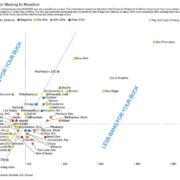Texans don’t leave, checklist for opportunity cities, exurbia rising
Lots of good stuff this week:
- From Texas Monthly, “The Newest Texans Are Not Who You Think They Are“
“In fact, a primary reason Texas is growing so fast is that we tend to stick around as compared to natives of other states, meaning there’s less out-migration to offset the in-migration. About 82 percent of people born in Texas still live here, making it the so-called stickiest state in the country.
- American Affairs Journal: Exurbia Rising by Joel Kotkin, packed with great stats. Here’s the opening paragraph:
“Perhaps nowhere is the gap between America’s cognitive elite and its populace larger than in their preferred urban forms. For nearly a century—interrupted only by the Depression and the Second World War—Americans have been heading further from the urban core, seeking affordable and safe communities with good schools, parks, and a generally more tranquil lifestyle. We keep pushing out despite the contrary desires of planners, academic experts, and some real estate interests. In 1950, the core cities accounted for nearly 24 percent of the U.S. population; today, the share is under 15 percent, according to demographer Wendell Cox. Between 2010 and 2020, the suburbs and exurbs of the major metropolitan areas gained 2.0 million net domestic migrants, while the urban core counties lost 2.7 million.”
- The Bush Institute: The Evolving Geography of Opportunity: Leading Cities of the Past, Present, and Future
“Lessons from history and from the relative success stories of the present point to clear priorities for today’s cities:
-
- Get the urban basics right: schools, safety, livability.
- Strengthen local anchor institutions in higher education, health care, and other areas.
- Invest aggressively in local quality-of-life amenities.
- Rebuild and expand critical infrastructure.
- Work toward openness, diversity, inclusion, and a welcoming approach to newcomers.
- Ensure a high degree of economic freedom.
- Emphasize housing affordability and work to build an opportunity-rich physical environment.”
- WSJ: People Are Going Out Again, but Not to the Office – Only a third of U.S. employees have returned to the office, as workers prefer remote and companies fear ordering them back. Companies that force employees to the office will have to pay more (including office costs) for inferior talent from a more limited local talent pool. Excerpts:
“Elected officials are imploring companies to send workers back to the office.”
“Business leaders, tell everybody to come back,” said New York Gov. Kathy Hochul, in remarks before a civic organization earlier this month. “Give them a bonus to burn the Zoom app and come on back to work.”
The gap between public enthusiasm for office return and other activities underscores the wide range of factors other than health considerations that are slowing the return to work. After close to two years of working from home, surveys suggest most employees simply prefer it to the office, which often requires lengthy commutes and gives workers less flexibility in how they spend their days.
Employers have also been reluctant to insist that workers return for fear of driving employees away during a labor shortage, corporate surveys show. Many managers feel remote work disrupts efforts to promote a corporate culture and collaboration, but they aren’t applying much pressure because studies have shown that many workers are as productive—or even more productive—when they work remotely.
“They feel like remote work isn’t perfect, but it’s working pretty OK,” said Brian Kropp, chief of human-resources research for the advisory and research firm Gartner. “There’s not a real urgency to change it.”
- Houston #2 for tree cover among major metros (just behind Atlanta) with 30% tree canopy coverage in the metro. Technically it shows Austin as higher (34%), but their number is from the early 90s, and we all know how much development has happened in Austin since then!
- Antiplanner: The 15-Minute City: A Idiotic Dream
We’re not going to double urban densities, especially when the doing so will fail to eliminate driving anyway. As urban economist Edward Glaeser once wrote (as quoted by Bertaud), the 15-minute city “should be recognized as a dead-end which would stop cities from fulfilling their true role as engines of opportunity.”
Finally, I’d like to end with this video on why Pakistanis are moving to Houston (hat tip to George). Although I wish it didn’t have the politics. She has some fair points about parts of rural Texas, but it muddles the video. I also think it completely misses the impact of lack of zoning and development regs that allowed those ethnic suburbs and shopping areas to develop. A lot of more regulated and zoned cities would have subtly (and not so subtly) prevented that from happening.
This piece first appeared on Houston Strategies
Tory Gattis is a Founding Senior Fellow with the Urban Reform Institute (formerly Center for Opportunity Urbanism) and co-authored the original study with noted urbanist Joel Kotkin and others, creating a city philosophy around upward social mobility for all citizens as an alternative to the popular smart growth, new urbanism, and creative class movements. He is also an editor of the Houston Strategies blog.









